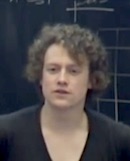Pierre-Antoine Guihéneuf
IMJ-PRG, Sorbonne Université, Paris
https://webusers.imj-prg.fr/~pierre-antoine.guiheneuf/
Date(s) : 05/01/2016 iCal
11 h 00 min - 12 h 00 min
Est-il possible de faire tourner plusieurs fois une image numérique sans perdre en qualité ?
Dans cet exposé, on étudiera ce problème pour l’algorithme le plus naïf de rotation discrète : la discrétisation. Par définition, l’image du point x par la discrétisation de l’application linéaire A\in Gl_n(R) est le point de Z^n le plus proche de Ax. Cela définit un endomorphisme  de Z^n, en général non injectif ; le défaut d’injectivité – i.e. la perte de qualité de l’image numérique – est mesuré par la densité de l’ensemble Â(Z^n).
Cet exposé sera centré sur le théorème suivant : Lorsque la suite (A_k) est générique parmi les suites de matrices de déterminant 1, la densité des ensembles (Â_k o Â_k-1 o … o Â_1)(Z^n) tend vers 0 lorsque k tend vers l’infini. J’essaierai d’expliquer comment ce résultat peut être utilisé pour étudier les discrétisations de C^1-difféomorphisms génériques, et de donner quelques idées de sa preuve, qui utilise le formalisme des quasicristaux.
Discretizations of linear applications and applications to diffeomorphisms
Is it possible to rotate a digital image several times without losing quality?
In this talk, we will study this problem for the most naive algorithm of discrete rotation: discretization. By definition, the image of point x by the discretization of the linear map A \ in Gl_n (R) is the point of Z^n closest to Ax. This defines an endomorphism  of Z^n, which is generally non-injective; the lack of injectivity – i.e. the loss of quality of the digital image – is measured by the density of the set  (Z^n).
This talk will focus on the following theorem: When the sequence (A_k) is generic among the sequences of matrices of determinant 1, the density of the sets (Â_k o Â_k-1 o … o Â_1) (Z^n) tends towards 0 as k approaches infinity. I will try to explain how this result can be used to study the discretizations of generic C ^ 1-diffeomorphisms, and give some ideas of its proof, which uses the quasicrystals formalism.
https://tel.archives-ouvertes.fr/tel-01213519/
Catégories

